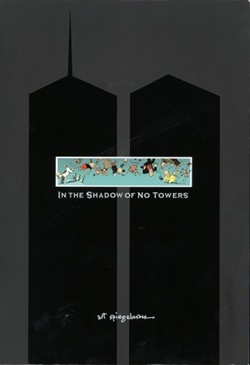 “That was all washed away by the rains and the police as the world hustled forward into our “New Normal.”
“That was all washed away by the rains and the police as the world hustled forward into our “New Normal.”
-Art Spiegelman
I’ve wrestled with how I feel about this book on almost a biannual basis over the last five years, but I’ve come to the lingering conclusion of late that it is to my feelings about September 11th, the Bush/Cheney administration, and the condition we’ve culturally been corralled into what prog metal like Dream Theater is to general emotional frustration. On a conceptual level, I’m more inclined to refer to it as a graphic essay than I am a graphic novel, because there really isn’t a cogent narrative across its pages so much as it is an extended op-ed about about how a cartoonist with an awareness of his medium’s history contends internally with recurring themes and unresolved persisting conflicts on national and global scales.
The second half of the book then functions more like a montage testament to Spiegelman’s essay from the first half. This book isn’t uniform, and it’s unapologetic about its unbalanced, wandering format, which reinforces its likeness to a giant minicomics zine. Herein lies In the Shadow of No Towers place in comics as a monolithic editorial grown within an industry and out of the newspaper funnies that gave birth to comics as we know them in the 20th Century.
As an object that looks like an artificial newspaper while you read it, this book draws a parallel between that relationship with a dying format and its representation of the Towers themselves, which Spiegelman claims to have had little affinity for beyond his nostalgia for the time they represented. He compares them to an ugly nose, which someone may dislike but would never wish to have destroyed.
The book maps out the intersection of Spiegelman as a creator directly impacted by the Nazi concentration camps of Maus with the warring ideologies and forces that intersected and produced the events of September 11th. There’s a severe lack of continuity page by page as Spiegelman modulates across topics, touching on his firsthand account and stepping back to offer historical context. Its greatest weakness is that as whole it doesn’t possess a consistent language or voice. Since every page introduces a different format and in most cases a collage of other people’s characters and symbols, Spiegelman himself gives a tour of imagery more than he succeeds in generating a definitive graphic novel as he did with Maus. Moreover, it contemplates his manic inability to come to terms with the present by flashing back and recounting history without ultimately making an assessment about the “New Normal” that he identifies in the introduction.
There’s no self-imposed pressure at work demanding a conclusion, but the open-ended deferral to show-and-tell for the second half of the book settles on the question of why things stay the same more than they change instead of providing resolution.